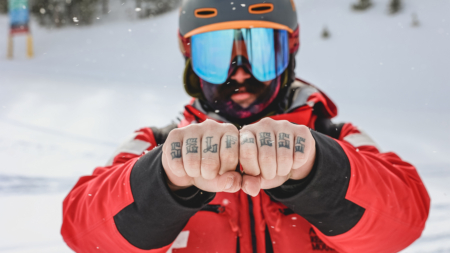Cold Smoke, Hot Shot
The air sang with wind and fresh snow as Evan Green and I stepped out of my truck at Red Lodge Mountain, Montana. The prairies where my Lakota ancestors hunted buffalo stretched far and wide below the Beartooth Mountains. I stood only one valley away from where the Battle of the Greasy Grass, known more commonly as Custer’s Last Stand, took place. Despite the Lakota, Northern Cheyenne and others defeating Custer, the national forest still bears his name.
I wiped fresh snow from my skis, uncovering a sticker: “You Are On Native Land.” The land beneath my feet knew the people who came before me, people who spoke a language to the land and its inhabitants that I struggle to learn now. We once lived in spiritual and cultural reciprocity with this place. Here, Peter “Petey” Gannon would guide me toward a newfound relationship with the land. Our friend Micheli Oliver was on her way to join us.
I rolled the windows down as I was driving, Micheli recalls, and took a full gulp of frigid Montana air. Air my ancestors once breathed. I recalled traveling through these lands when I was 4 years old on a road trip with my parents and baby brother.
My mom tells a story from that trip often: We were winding through forest roads when I saw the devastation caused by a wildfire from my window. I asked my parents to pull over. The moment we stopped, I ran to the burnt forest and began to cry: “The tree spirits, Momma. I can hear the spirits crying.”
There’s an intuitive knowing that kids have, an ability to talk to our ancestors, to our tree relatives—not talking in the Western conventional way, but in the Indigenous way of conversing, listening and understanding. To this day I talk to the forests.
“I’m home,” I said aloud as I drove through the ancestral lands of the Niitsitapi, Očhéthi Šakówiŋ, Tséstho’e and Apsáalooke peoples. My heart knows more than my brain when I get back to the land of my ancestors.
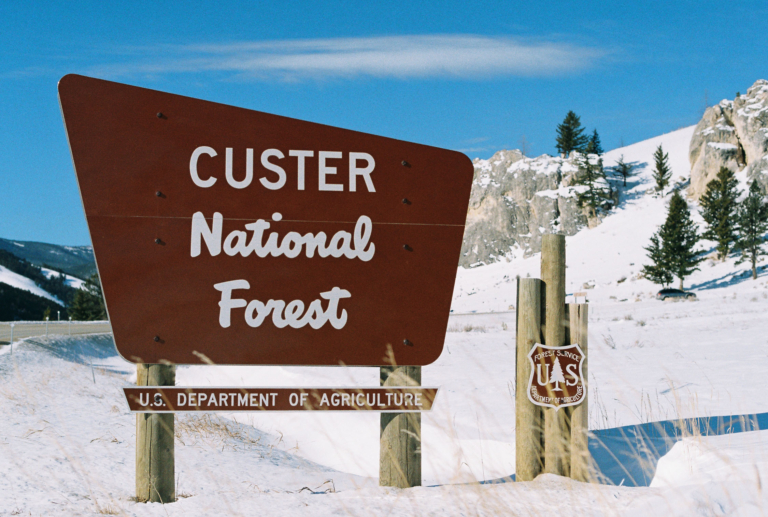
Although Custer lost the Battle of the Greasy Grass, the national forest in which Red Lodge Mountain operates still bears his name. Photo: Evan Green
With Micheli still en route, we met Petey. I’d only talked to him through social media before, and this in-person connection was a long time coming.
Petey grew up in South Dakota’s Pine Ridge Reservation. Now, he lives in Montana. He is the only Indigenous ski patroller I know. I am hopeful he is not the only one. He’s also a wildland firefighter in the summer, having recently dedicated his life to helping others after reconnecting with the land and his heritage.
With fresh snow on our minds, Petey headed off to grab his gear while we hustled off to pick up our lift tickets. Stepping out of the lodge, I turned to grab my skis from the racks outside, but they were gone.
It was easy to jump to conclusions. I thought my skis had been taken because someone saw a tall Native skier with long braided hair who had stickers celebrating Indigenous activism. I felt like a target because of the things I so proudly work to reclaim: my culture and my rights to remain connected to and responsible for the land.
After a few minutes racing around trying to spot my skis, Evan and Petey called over to me. Someone on the beginner lift had my skis on. Soon, a man with a handlebar mustache, a Bud Light ball cap and a camouflage hunting jacket stepped gingerly out of my bindings. “I guess these weren’t my rentals. Sorry ‘bout that,” he chuckled.
It turned out this perpetrator had no malicious intentions. He just didn’t know how to differentiate between red 160cm rentals and my green and orange 190cm skis. If he had looked down, he would have seen Lakota words, artistic calls for the return of Native land.
Petey and Evan beckoned toward the main lift. There was fresh snow waiting. We would soon be joined by Micheli to fill the quad.
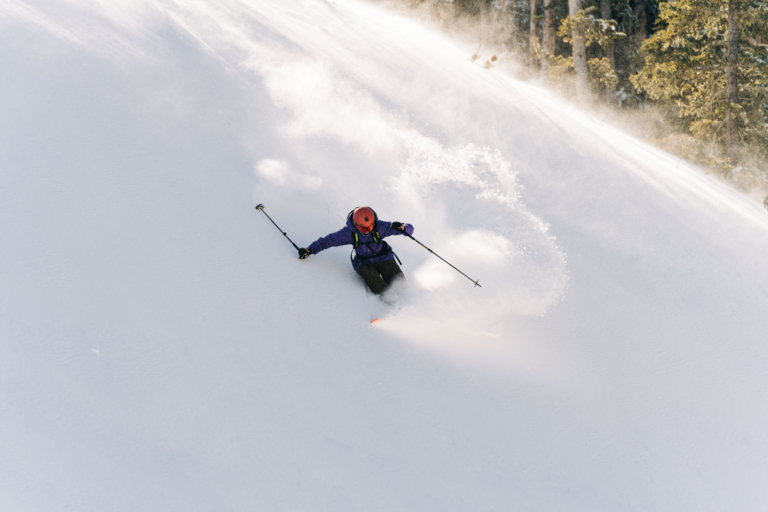
Connor Ryan connects with cold smoke at Petey’s home mountain, Red Lodge Mountain. Photo: Evan Green
As I drove, my eyes darted from the road to the ponderosa pines, Rocky Mountain junipers, Douglas firs, Engelmann spruces, lodgepole pines, whitebark pines and subalpine firs, Micheli remembers. I saw an overall lack of maturity in the forest, thin trees that haven’t seen fire for a very long time. Historically, there have not been so many trees—we are in unprecedented times regarding fire dynamics.
By the time I arrived at the resort, my brain was overflowing with forest and fire ecology and an old thought: “To get to know a land you must first get to know her people.”
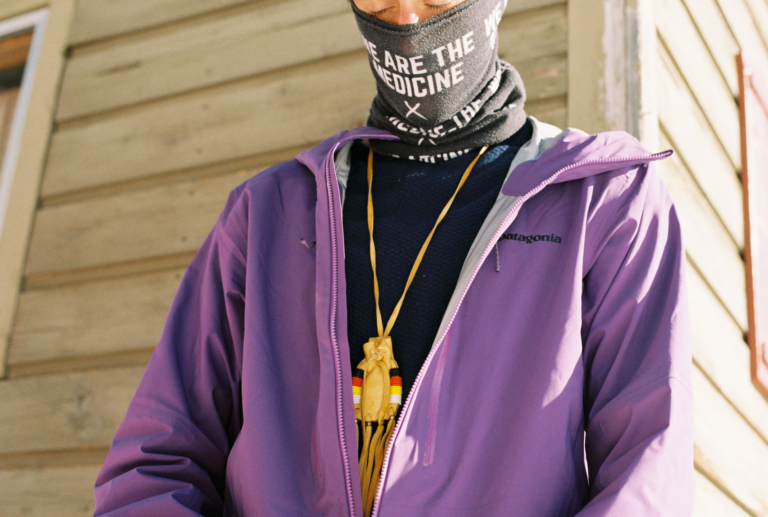
Close to the heart. Connor pauses for a moment of reflection before carrying his heritage proudly into the mountains. Photo: Evan Green
Petey led us to powder stashes and perfectly spaced trees. On the rides back up, he spoke with authority about the mountain. It felt like he had been here for many years, but this was his first season as a ski patroller and only his third as a skier. He moved to Red Lodge to work construction and be closer to nature. “I will never ski. That’s for rich white people, that ain’t me,” Petey thought at the time. However, during his first winter in Red Lodge, construction slid to a snowy halt and the mountain was the only place hiring. Petey got a job scanning tickets at the base area.
Like me, skiing became a way for Petey to deepen his reciprocal relationship with the land. In Lakota lore, many of the songs were first sung by the wind passing through the pine-covered hills and mountains. Petey heard this chorus as the soundtrack of learning to ski. The confidence of the land informed him, and he fell in love.
Petey told stories of rescues on the mountain. The snow intensified as he turned his gaze to the forest below. He explained how climate change and lack of fire had affected forests in this range, leading to an overgrowth of pine needles and old man’s beard. He began telling stories of fighting fires in Oregon the previous summer, when one of the most devastating fire seasons on record burned more than 1 million acres of land, destroyed thousands of homes and killed 10 people. He and countless other brave men and women, a disproportionate number of them Indigenous, still lovingly fought to protect stolen lands.
Petey knows the history of this land, and he lives its present manifestations daily. Whether fighting fires or ski patrolling, he cares for people, looks out for them unconditionally and protects them from season to season. Most would never understand the true depth of what he overcame to do that, putting down a legacy of historical trauma to be a steward for the land, and all life on it, without exception.
I asked Petey about this dichotomy and he told me, “I just wish they loved Native people like they love Native land.”
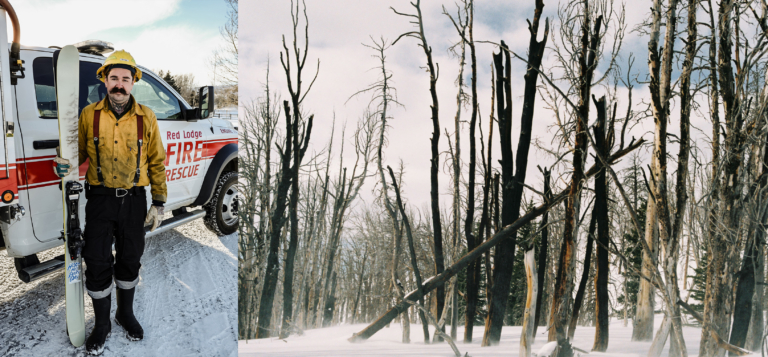
Left: Whether flames or flakes await him, Petey stands ready to answer the call of the forest. Photo: Micheli Oliver
Right: Charred trees in the Montana backcountry provide evidence of a wildfire that recently swept through these hills. Photo: Evan Green
Micheli arrived: I quieted my brain and found Connor, Petey and Evan at the chairlift. It was easy since they were the only three people of color at the resort. I felt immediately comfortable with a Black and Indigenous group of skiers, finding joy together in this radical act of resistance that we are still here.
The next day we skied off the backside of the resort and toured into a recent burn area, with its fascinating juxtaposition of dark black and brown against the soft white snow. It was a graveyard of sorts. As I skinned up, my mind wandered again to sacred fire practice. A passage from esteemed author and Indigenous scientist Robin Wall Kimmerer’s Braiding Sweetgrass came to mind: “Your own fire, your spirit. We all carry a piece of that sacred fire within us. We have to honor it and care for it. You are the firekeeper.”
Petey is a firekeeper, even if he doesn’t know it. Indigenous connection to place is not just a spiritual one. Our spirits show us what we must do, but then it becomes a similar science to that of Western settlers, full of trial and error, full of passed-down experiments and intimate knowledge of a landscape.
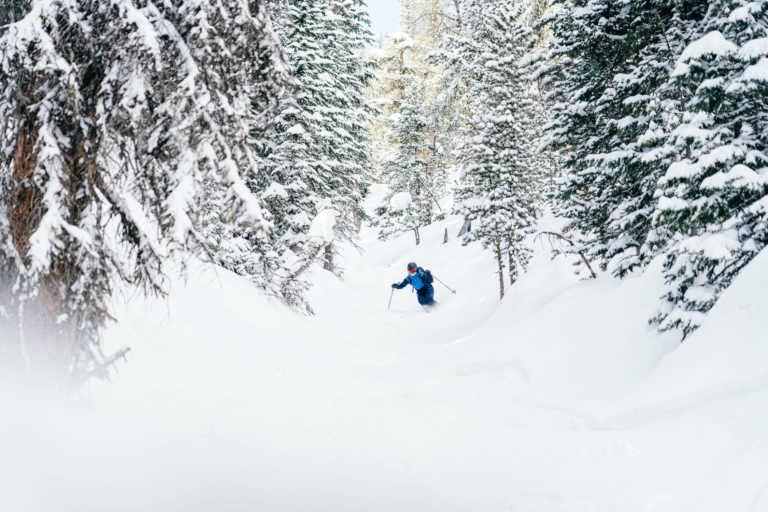
Micheli Oliver dives into a powder-filled gully, one of her favorite ways to connect with a new landscape. Photo: Evan Green
Now, we are seeing the land suffer without Indigenous fire and spirit. The Blackfeet Nation and other tribes from the region have utilized fire as a tool and sacred practice to manage forests and our livelihoods for millennia. Even tribes from the plains used fire practice. The place we were skiing had been scarred by a particularly hot fire, the type of fire that leaches the soil of nutrients, which traveled high in the treetops with plenty of fuel and oxygen to burn. This type of fire—a crown fire—is more likely these days because of human fire suppression and increased dryness and temperatures due to climate change. Fire suppression allows invasive species to take hold, decreasing soil nutrients and leading to the decline of native flora and fauna. Crown fires grow more likely with each passing year without fire as invasive species flourish and create more fuel.
Fire suppression comes in part from the perspective that forests are not a home. Rather, forests are a place of profit for the timber industry. To suppress wildfires is to ensure future profit. The wilderness is seen as a separate entity from humans. There is no reciprocity with the land. Indigenous ways of being—working with nature in a non-hierarchical society—stood in direct opposition to this extractive perspective.
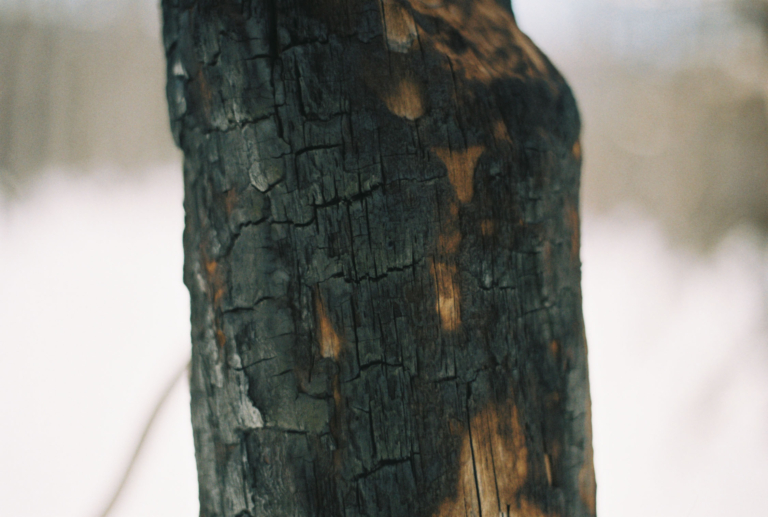
Details of a forest fire. This tree likely burned in a 2015 blaze that briefly required evacuation of Red Lodge Mountain. Photo: Evan Green
Traditional burning is not part of fire suppression. Known today as prescribed burning, this process was first use by the original peoples of an area. For woodlands Native people, traditional burning was utilized for soil germination, habitat improvement for aquatic life and to help the forests resist lightning-started fires. For plains Natives—Connor, Petey and my ancestors—fires were often set for the movement of bison, or as my people call them, iinnii. The fires set in grasslands would lead to more nutrient dense and prosperous grasses, and the bison would follow these burns.
The removal of people from land, and land from people, has created wildfire potential like we have never seen. The trees need the original people, and they seem to sing when we return. Petey, Connor and I know this. As we skinned to the top of this burn, among a graveyard of our relatives, we cried for what was. As modern Natives, we mourn, we find joy, mourn and find joy again. It is a cycle we are used to in a settler state, a cycle we do to survive.
At the top of the burn, we pushed down our mourning and found joy in movement. With each turn, we were all reminded of the work we must do—work for the land in Petey’s case. His connection to snow and to fire as he works to help the land his ancestors are woven into. Connor’s work for representation and Indigenous voice. All of our work for land back and Indigenous sovereignty and self-determination.
“Fire will return to this land,” I thought, “Fire must return. And alongside it, Indigenous peoples must return.”
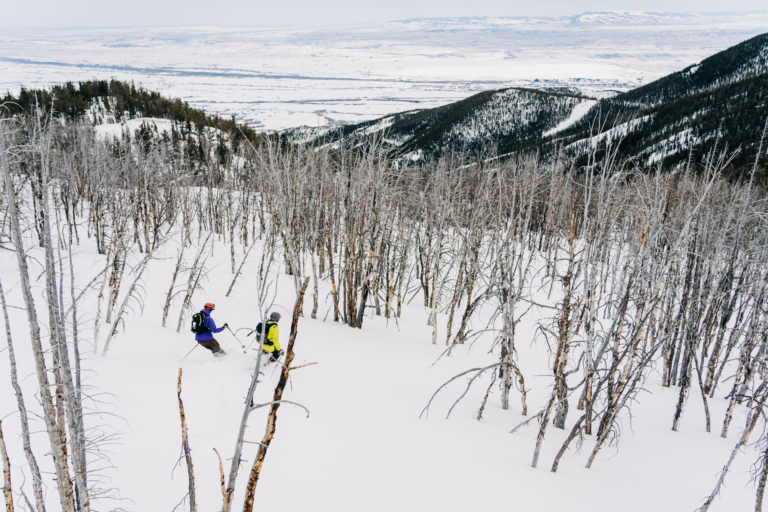
Petey and Connor share turns in a burned forest above Red Lodge Mountain, reminding themselves that a landscape touched by fire can still be loved. Photo: Evan Green
Laughter filled the air as we all sat in a motel room reviewing photos. I was grateful to have Petey as a tangible member of my community, and to have met someone who showed me that I wasn’t alone in seeing, hearing and experiencing the mountains as both a Lakota and a skier.
Petey trusts his perception of place as a Lakota and values his cultural identity deeply, yet he works in a national forest named after Custer and lives in a town that he said “has more statues of Indians than actual Indians.” I still wondered: How does he focus on the importance of his work over all the noise of a racist history colliding with the present moment?
Petey spent his teenage years as a troublemaker in Rapid City, South Dakota. He was kicked out of high school and sent to live with his grandfather on the edge of the Black Hills. His grandfather took him to traditional ceremonies—sweat lodges, Sun Dances—and he was put up on the hill for days to do vision quests. He saw and experienced things that changed his perception of the world. Ceremony became central to his life and his family’s, even getting to bring his father, who is of Norwegian descent, into the cultural fold. The transformative and healing powers touched their lives. Then about a year after he graduated, Petey’s dad was hit and killed by a drunk driver on the way home from a branding. “It ruined my world,” Petey says.
Yet Petey did not doubt his cultural and spiritual teachings. In the weeks after the accident, Petey got to know the driver and his family and tried to seek healing in a traditional way. The white side of Petey’s family resented this. But Petey did not give in to hate or hurt. “In trial, I testified for a different style of punishment because an eye for an eye just leaves everyone blind,” he said. “I had just lost my dad, my mother lost a husband, my sister lost a dad. That sucks, dude. But this man has two little girls. If I press that he goes to jail for the next 30 years, then his wife just lost a husband and those little girls don’t have a dad anymore. And what is he learning there, in the prison system? He’s not learning to be sorry. He’s learning to survive. My mom and her side of the family understood that. It’s a healing circle, and you don’t just cut it in half.”
Most of his dad’s side of the family still refuses to talk to Petey for making this choice. “If you step away and look at it selflessly from a distance, there is only one way that everyone heals in this,” Petey said. “It is the Native, circular, healing way.”
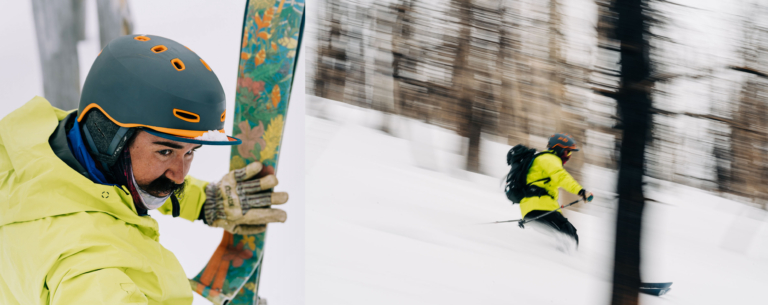
Left: Petey puts on skins before leading the group into the burn zone above Red Lodge ski area. Photo: Evan Green
Right: Sliding on the snow in his new home, Petey has found a new way to connect with the land. Photo: Evan Green
Petey learned to trust a larger process. He carries this forgiveness up onto the mountain and out into blazing fires. My time with him was filled with moments of subtle surrender to the way things are, not because he didn’t want to change the world, but because he knows judgment alone doesn’t bring about healing. Our presence and perspectives are necessary, but we also cannot reach our goals alone.
“I just want to help the people,” Petey said. “I don’t know if it’s through just having a better voice or to move somewhere I can make a bigger difference …”
He trailed off without knowing the exact answer and knowing none of us in that motel room had it either. We are just beginning to understand how to work within current society to heal the land.
Petey bid us farewell, stepping out into the cold air of the night. The next morning he’d be up on that mountain again early, listening to the song of the wind in the trees.
